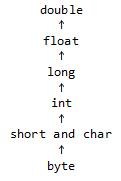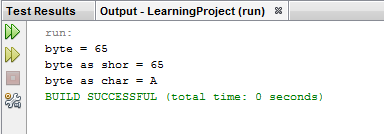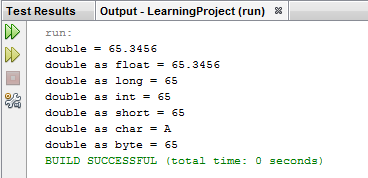What do we mean by "Type Casting"?
Type casting is basically the process of changing or converting one variable from one data type to other different data types. For example, we may want to convert an integer variable data type to a long data type. For the primitive data types, The type casting can be performed only on the numbers. We can think of a char data type as a number since it is one of the Integral Data Types. We cannot perform casting on boolean.
What is an Integral Data Type?
An integral data type is a data type that represents a subset of the infinite integer set (such as byte, short, int, char, long in Java Language).
- Narrowing primitive conversion
- Widening primitive conversion
Before we continue with the meaning of each one, we have to know few things. Java data types are grouped into 3 groups, The Integral Types, Floating and the boolean. The integral group contains the types that does not have a decimal point. It includes the int, byte, short, long and the char. The floating group contains the types that has a decimal point. The floating group contains two data types, the double an the float. The boolean group contains only the boolean data type. Each data type has a specific size. The double is 64 bits, the long is 64 bits, the float is 32 bits, the int is 32 bits, the short is 16 bits, the char is 16 bits and the byte is 8 bits.
The next table shows the summary of data types sizes.
| Group | Data Type | Size |
|---|---|---|
| Floating | double | 64 bits |
| float | 32 bits | |
| Integral | long | 64 bits |
| int | 32 bits | |
| short and char | 16 bits | |
| byte | 8 bits |
Widening Primitive Conversion
Sometimes called Automatic Type casting. It can happen when we try to cast a small size type to a larger size type. For example, we may want to convert from a short to an int. Also we can cast from Integral type to floating type in widening primitive conversion.
| Group | Data Type | Size | - |
|---|---|---|---|
| Floating | double | 64 bits |  |
| float | 32 bits | ||
| Integral | long | 64 bits | |
| int | 32 bits | ||
| short and char | 16 bits | ||
| byte | 8 bits |
Java
Java 6 and Above
Java 6 and Above
public class Main{
public static void main(String [] arguments){
//the original value
byte myByte = 65;
//changing from byte to short
short byteAsShort = myByte;
//changing from byte to integer
int byteAsInt = myByte;
//changing from byte to double
double byteAsdouble = myByte;
//from long to double. Notice the 'L'
double longAsDouble = 77L;
//from float to double. Notice the 'F'
double floatAsDouble = 67F
System.out.println("byte = "+myByte);
System.out.println("byte as short = "+byteAsShort);
System.out.println("byte as integer = "+byteAsInt);
System.out.println("byte as double = "+byteAsdouble);
System.out.println("byte as double = "+byteAsdouble);
System.out.println("long as double = "+longAsDouble);
System.out.println("float as double = "+floatAsDouble);
}
}
One thing to notice about widening primitive conversion is when we try to cast a byte or a short to a char. In order to cast from byte to char, we have to till the compiler that we are changing from byte to char. Same thing apply when we are casting from short to char. The following code example shows how to do that.
Java
Java 6 and Above
Java 6 and Above
public class Main{
public static void main(String [] arguments){
//the original value
byte myByte = 65;
//changing from byte to short
short byteAsShort = myByte;
//changing from byte to character. Notice the '(char)' thing that we have added
char byteAsChar = (char)myByte;
System.out.println("byte = "+myByte);
System.out.println("byte as short = "+byteAsShort);
System.out.println("byte as char = "+byteAsChar);
}
}
Narrowing Primitive Conversion
Narrowing primitive conversion is the opposite of Widening primitive conversion. What we do is we convert a larger size data type to a smaller one. To complete this task, we have to tell the compiler explicitly about the conversion. We do that by doing the same thing when we wanted to convert from byte to char.
| Group | Data Type | Size | - |
|---|---|---|---|
| Floating | double | 64 bits |  |
| float | 32 bits | ||
| Integral | long | 64 bits | |
| int | 32 bits | ||
| short and char | 16 bits | ||
| byte | 8 bits |
The following code example shows how it is done.
Java
Java 6 and Above
Java 6 and Above
public class Main{
public static void main(String [] arguments){
//the original value
double myDouble = 65.3456;
//changing from double to float
float doubleAsFloat = (float)myDouble;
//changing from double to long
long doubleAsLong = (long)myDouble;
//changing from double to int
int doubleAsInt = (int)myDouble;
//from double to short
short doubleAsShort = (short)myDouble;
//from double to char
char doubleAsChar = (char)myDouble;
//from double to byte
byte doubleAsByte = (byte)myDouble;
System.out.println("double = "+myDouble);
System.out.println("double as float = "+doubleAsFloat);
System.out.println("double as long = "+ doubleAsLong);
System.out.println("double as int = "+doubleAsInt);
System.out.println("double as short = "+doubleAsShort);
System.out.println("double as char = "+doubleAsChar);
System.out.println("double as byte = "+doubleAsByte);
}
}
What Happened to the Decimal Point when We cast from float or double to a type that has no Decimal Point? When we cast from floating type to integral type, the number will be always truncated (the numbers after the decimal point will be cut down).
Java
Java 6 and Above
Java 6 and Above
public class Main{
public static void main(String [] arguments){
//the original values
double firstDouble = 88.49;
double secondDouble = 88.50;
double thirdDouble = 600.90;
double fourthDouble = 600.0001;
//changing from floating to integral type
int firstDoubleAsInt = (int)firstDouble;
int secondDoubleAsInt = (int)secondDouble;
int thirdDoubleAsInt = (int)thirdDouble;
int fourthDoubleAsInt = (int)fourthDouble;
System.out.println("first double = "+firstDouble);
System.out.println("first double as int = "+firstDoubleAsInt);
System.out.println("second double = "+secondDouble);
System.out.println("second double as int = "+secondDoubleAsInt);
System.out.println("third double = "+thirdDouble);
System.out.println("third double as int = "+thirdDoubleAsInt);
System.out.println("fourth double = "+fourthDouble);
System.out.println("fourth double as int = "+fourthDoubleAsInt);
}
}




Great article!!
ReplyDeleteRegarding last part, "When we cast from floating type to integral type, the number will be always rounded down". The number will be truncated.
So, -88.5 won't be rounded down to -89 but truncated to -88.
Thanks for your note. I just updated the text. If a number is truncated, it is kinda rounded down. -88.5 will be -88.0 if it is rounded down and will be -89.0 if rounded up. The only difference is that if a number is truncated, the .0 will be removed (e.g. 88.5 will be 88 without decimal point).
Delete